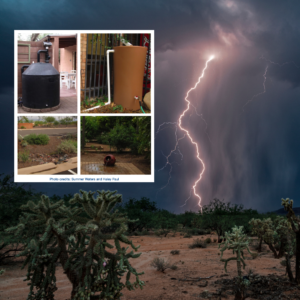Monsoon season has officially begun, which means heavy rains and high winds are on the horizon. Before the storm season kicks into high gear, it’s important to prepare your property to minimize potential risks and ensure proper water management. Follow these guidelines to safeguard your property and contribute to Arizona sustainable water practices.
- Identify the drainage style for your property:
Understanding your property’s drainage style is crucial for effective water management. Determine whether you have a self-retention or U-drain lot. This knowledge will help you plan structures and walls without obstructing the natural flow of water. Seek professional guidance if you’re unsure about your property’s drainage style.
- Create a dry creek bed:
Constructing a dry creek bed, also known as an arroyo, helps control water flow during heavy rains. By digging a shallow trench and filling it with rocks or stones, you can guide rainwater safely through your property without causing soil erosion. Enhance your landscape by planting shrubs and plants along the arroyo, creating an attractive focal point.
- Use the right plants:
Choose desert-adapted plants that absorb ground water effectively. Perennials, shrubs, and cacti are great options for absorbing rainwater. If feasible, consider incorporating saguaros into your landscape as they can extend their roots to seek out water. Minimize water consumption by opting for these plants instead of maintaining a grass lawn.
- Check your irrigation system:
During monsoon season, adjust your irrigation system to account for the increased rainfall. Cut back on water usage by aligning irrigation schedules with the forecasted rain events. By doing so, you’ll save water and reduce your water bill. Take advantage of timers and settings in your irrigation system to optimize its efficiency.
- Install and clear out gutters:
If your home lacks gutters, consider installing them to direct water flow during storms. Properly positioned gutters and downspouts will ensure water is directed away from your home’s foundation, preventing pooling and potential damage. Regularly inspect and clear out gutters to avoid blockages caused by debris or nesting birds.
” Water Conservation: Harvesting Rainwater “
Active Rainwater Harvesting:
Active rainwater harvesting involves collecting rainwater in containers, tanks, or barrels for later use. Gutters direct rainwater into these containers, which should have screens to keep out debris and pests. Consider using a first flush device for cleaner water. Underground storage tanks can also be utilized, requiring a pump to bring water to the surface for use in irrigation systems or water features.
Passive Rainwater Harvesting:
Passive harvesting focuses on shaping the landscape to slow water flow and promote infiltration into the soil. Features such as berms, basins, contours, and swales help retain rainwater, ensuring it benefits your landscape and reduces runoff. This technique supports the deep watering needs of desert-adapted plants while conserving water
Preparing your home and yard for monsoon season is crucial to safeguarding your property and conserving water. By identifying your property’s drainage style, creating a dry creek bed, using appropriate plants, checking your irrigation system, and installing/clearing out gutters, you can mitigate potential risks and ensure water flows safely. Additionally, consider active and passive rainwater harvesting techniques to conserve water and support sustainable practices. For personalized guidance and professional assistance, consult experts in the field.
SOURCES: Town of Queen Creek Az , Queen Creek Sun Times , Arizona Cooperative Extension



